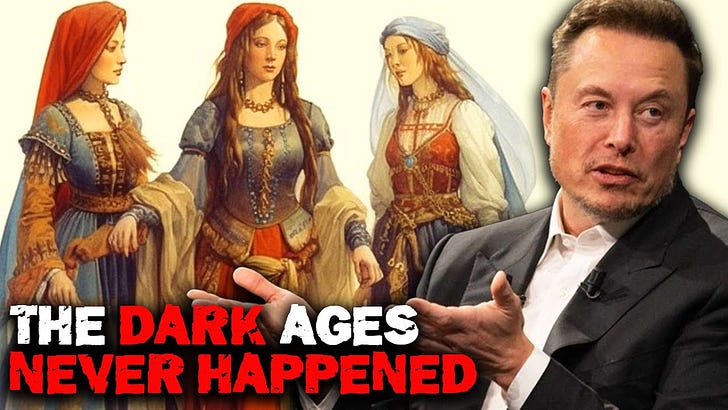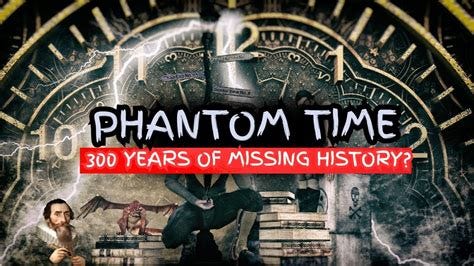The 300-Year Hole in History?
substack.com /home/post/p-163458084

What Are We Missing and Why?
Have you ever had that strange feeling that something in our collective past just doesn’t add up? Maybe you’ve come across old architecture that seems too advanced for its time. Or timelines in historical records that feel suspiciously neat. Or perhaps you've stumbled onto whispers of a mystery many researchers and thinkers—often written off as fringe—call "phantom time." What if the history we've been taught isn't just distorted... but deliberately edited?
A Distorted Timeline?
Let’s get something straight: historical chronology isn’t a simple, unbroken chain. Much of what we “know” about the past was pieced together by medieval monks, Renaissance scholars, and 19th-century academics with biases, missing data, and in some cases, agendas.
The most famous version of this mystery is called the Phantom Time Hypothesis, proposed by German historian Heribert Illig in the 1990s. He argued that nearly 297 years of history (specifically AD 614 to 911) were either fabricated or misdated. According to this theory, we are not living in the 21st century but rather in the 18th—because three centuries were inserted into the timeline during the early medieval period.
Illig pointed fingers at Holy Roman Emperor Otto III, Pope Sylvester II, and the Byzantine Emperor Constantine VII, who allegedly conspired around the year 1000 AD to place themselves in a more significant historical context. They wanted to rule during a "millennium" year and rewrote or adjusted existing documents to make it seem so.
If this is true—or even partially true—it would mean much of the “Dark Ages” never actually happened the way we think they did. Which brings us to the next question…
Where Are the Artifacts?
Archaeological findings don’t always line up with written records. There’s a noticeable lack of material culture, construction, and innovation dated solidly within the 7th, 8th, and 9th centuries—particularly in Europe. Architecture seems frozen during this time. Cities supposedly flourishing in historical records show no corresponding development. Then suddenly, by the 10th century, we see a spike in technological, architectural, and economic progress.
This “missing time” overlaps suspiciously well with the same AD 614–911 period Illig highlights.
Who Would Benefit from Changing Time?
You might ask: Why would anyone alter the calendar in the first place? The answer is the same as it always is—power, control, and legacy.
In a world where historical and religious legitimacy were everything, it’s not hard to imagine rulers rewriting the timeline to suit their reigns. Otto III and his allies had clear motivation to legitimize their rule by placing it within a symbolic year like 1000 AD—especially in the eyes of the Church.
Calendar systems add to the confusion. The Julian calendar, introduced in 45 BC, slowly drifted out of sync with the solar year. By the time Pope Gregory XIII introduced the Gregorian calendar in 1582, the seasonal calendar was 10 days off. But here’s the twist: correcting a 10-day drift would only require about 1,200–1,300 years of use. Yet the Church claimed it had been in use for over 1,600 years, going all the way back to Julius Caesar.
Where did the extra 300 years come from?
Why Don’t We Talk About This?
Mainstream historians are quick to dismiss the phantom time hypothesis as pseudoscience, often citing lack of documentation. But paradoxically, those same historians label the Dark Ages (roughly 500–1000 AD) as “dark” precisely because of the lack of documentation, architecture, and innovation. Which is it?
Historical narratives are pieced together from fragile records—often incomplete, sometimes politically motivated. Monasteries burned. Libraries were looted. Dynasties destroyed their predecessors’ legacies. Who decided what survived?
The fact that so much of our calendar and chronology comes from medieval and Renaissance sources—many produced under powerful religious or imperial authorities—should raise questions, not shut them down.
So What Happened?
We may never know for certain. But there is mounting evidence to suggest something strange happened between the 7th and 10th centuries—a historical fog that refuses to lift.
Maybe it was an error. Maybe it was convenience. Or maybe it was a coordinated effort to erase, reframe, or invent the past.
Either way, if nearly 300 years of our timeline were manipulated or erased, the implications are enormous. Our understanding of who we are—and where we came from—would need a total rewrite.
History isn’t just what happened. It’s what survives. And sometimes, what survives is shaped more by those who hold the pen than those who lived the story. It’s what we’re allowed to remember.






Comments
Post a Comment
leave a message please